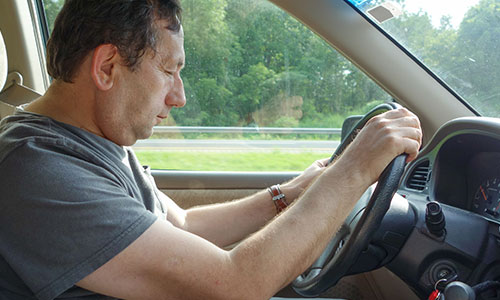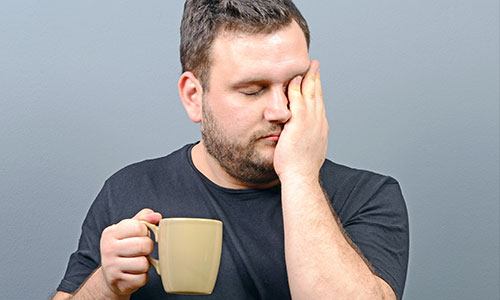6 signs sleep apnoea is ruining your day
- Overview
- Full article
- Related articles
The most common form of sleep apnoea is obstructive sleep apnoea or OSA. It happens when the muscles around your throat relax during sleep. This narrows the airway causing turbulent airflow, which results in snoring, as the walls of the airway vibrate. OSA occurs when the airway is so narrowed or floppy that it closes off completely as you try to breathe in.
Your brain reacts to the lack of oxygen by shocking your body out of deep sleep, usually with a loud snort. It’s enough to put a little tension in the muscles to open the airway, but not enough wake you up. And this can repeat almost every minute of every hour that you’re asleep.
Who’s at risk?
Sleep apnoea can affect anyone, but the typical patient is male, between 30 and 60 years’ old, with a BMI over 30 and a neck size of 17.5 inches or more. Men store more fat in their jowls and neck than women, increasing the likelihood of airway collapse during sleep. Women are more at heightened risk after menopause. About 4% of men and 2% of women live with OSA, but many cases go undiagnosed. If the following signs sound familiar, you could be one of them.
-
You’re under attack from a sleep deprived family
If you find yourself taking a barrage of complaints about your snoring from disgruntled family members or your partner, sleep apnoea could be to blame. Loud snoring, punctuated with sudden snorts and gasps, is a key symptom.
You’re a sleepyhead
Some people attribute their sleepiness to ageing, the stresses of work or the demands of family. These may well play a part, but healthy adults shouldn’t feel sleepy in the long term. What’s more likely is that you’re not sleeping well.
Many people who don’t sleep well know about it as they spend restless hours in bed and can’t fall asleep - the symptoms of conditions like insomnia. Those with sleep apnoea don’t wake up, at least not to a fully conscious level. Instead they can be jolted out of deep sleep hundreds of times a night by their brain forcing them to breathe, diminishing sleep quality.
Fatigue can quickly become dangerous. It’s a major contributor to vehicle and workplace accidents.
-
Mornings are a headacheAll of that jolting in and out of deep sleep releases stress hormones that leave you feeling a bit rough in the morning. Your brain releases adrenaline and cortisol to shock you into low consciousness. The levels of stress hardly have time to come down before it happens again and again and again, leaving you with elevated levels in the morning and a splitting headache to boot.

-
You need to pee in the night
This issue is often associated with prostate problems. This is a more likely culprit for older men. Men in their 30s, 40s and 50s may be experiencing sleep apnoea. The stress hormones released can contribute to a desire to get up and urinate during the night. -
Your libido isn't what it used to be
Low libido or sex drive can be a side-effect of raised stress levels spiking throughout the night. The symptomatic snoring can contribute to relationship breakdowns as both parties can lose sleep and become increasingly stressed. Commonly, partners of heavy snorers opt to sleep in a separate room, creating a further barrier to intimacy. - You’ve got high blood pressure
Living with sleep apnoea can raise your risk of cardiovascular diseases including high blood pressure, irregular heartbeat, stroke and heart attack. If you’ve been diagnosed with cardiovascular problems and notice other signs of sleep apnoea, tell your GP.
Diagnosis and treatment
The first step is understanding how fatigued you are during the day. Use this scale to learn your level of sleepiness. Take your score to your GP if you’re concerned.
A wearable sleep tracker is a good tool to inform yourself of your sleeping habits, but at present, there are few consumer products that can provide reliable clinical data without supervision. Used correctly, the data collected by your personal device can be a valuable tool for your GP or specialist.
To accurately diagnose sleep apnoea, patients are sent home with a small wearable monitor. It measures and counts dips in oxygen while you sleep. The results are used to diagnose the condition as mild, moderate or severe.
Mild OSA can often be treated with lifestyle improvements such as maintaining a healthy weight, stopping smoking, reducing alcohol intake and increased exercise. More severe conditions may be treated with a Continuous Positive Airway Pressure (CPAP) machine. This involves wearing a mask over the nose or face while sleeping. The positive air pressure prevents snoring and airway collapses, allowing a deep uninterrupted sleep.
This treatment will not cure sleep apnoea, but most patients find the improved sleep has a dramatic impact on their overall health and wellbeing and are happy to continue CPAP. Surgical options are rarely useful, but tonsillectomy or opening the nasal passages can sometimes help to reclaim a good night’s sleep.
Last updated Tuesday 7 June 2022
First published on Friday 29 July 2016

